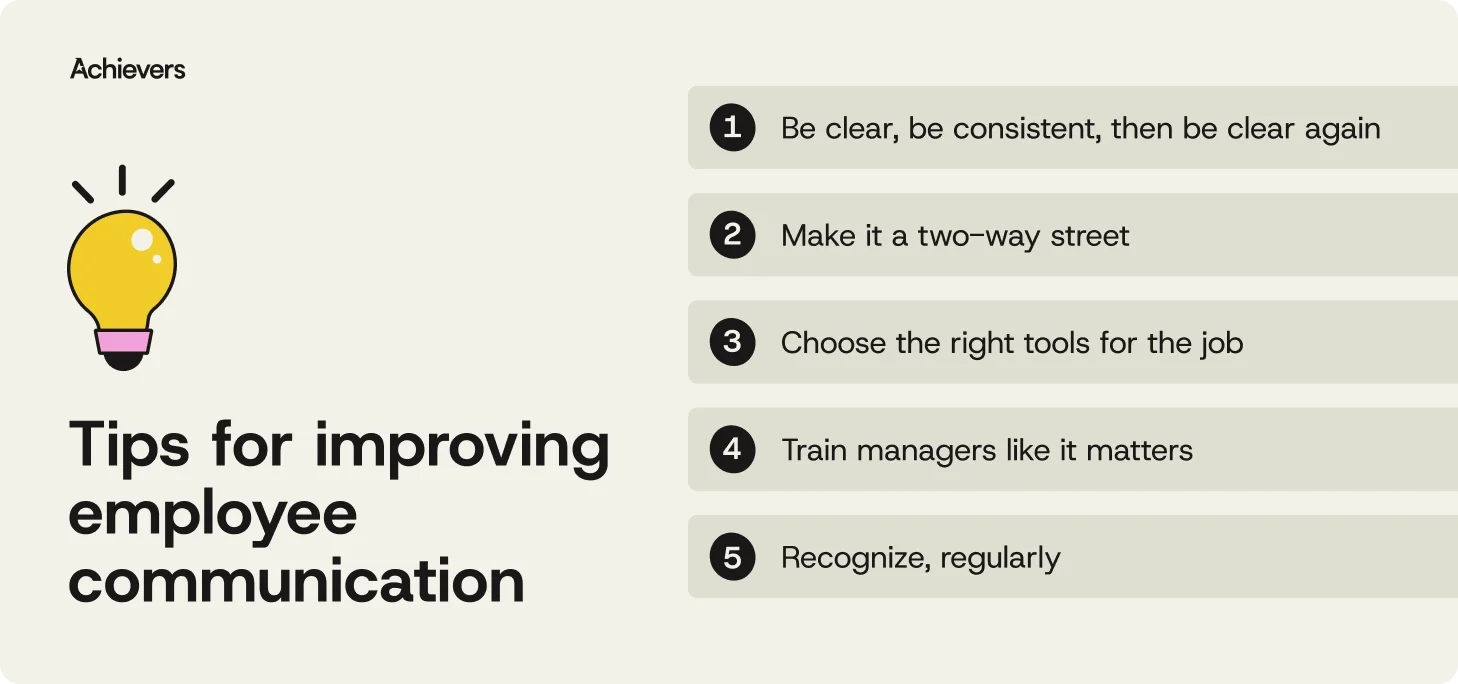Table of contents
Create a culture that means business™
Schedule a demo with an Achievers solution expert today.
Open, honest communication isn’t just workplace wallpaper — it’s the foundation of engagement, productivity, and retention. When employees feel heard, they’re more likely to stay, grow, and contribute. And when leaders actually listen? That’s when organizations start to hum.
But here’s the kicker: Despite its importance, effective communication often gets overlooked. One study found that 61% of employees considering a new job pointed to poor internal communication as a key reason. Ouch.
The good news? You don’t need to overhaul your entire organization to make a difference. Prioritizing communication — the real kind, not just another all-hands — builds transparency and trust. And that’s the kind of culture people want to be part of.
Want to get your team talking (and actually connecting)? Let’s dive into the how.
How to keep the conversation going (and actually mean it)
Communication in the workplace isn’t one-size-fits-all — it’s more like a five-piece toolkit. Verbal, written, nonverbal, digital, and visual communication each have a role to play in creating clarity, building trust, and making sure your message doesn’t vanish into the corporate ether.
When you use all five methods consistently, your people aren’t just informed — they’re included. And that’s the difference between sending a memo and sending a message that lands.
Here’s how each method pulls its weight:
- Verbal: The classics — meetings, phone calls, presentations, and that “got a minute?” chat that turns into a strategy session.
- Written: Emails, reports, documentation — great for details, accountability, and receipts.
- Non-verbal: Body language, facial expressions, and tone. Yes, even in Zoom meetings. Especially in Zoom meetings.
- Digital: Instant messaging, collaboration tools, and social platforms that keep things moving (and stop your inbox from collapsing under its own weight).
- Visual: Dashboards, infographics, videos, and charts — because sometimes a picture really is worth a thousand reply-all’s.
Use them well, and your team won’t just get the message — they’ll feel it.
Communication that actually connects (at every level)
Here’s the truth: Communicating with employees isn’t a one-size-fits-all gig. What resonates with an executive team might miss the mark entirely with your frontline staff. And that’s okay — as long as you’re tailoring your approach.
What is universal? Listening. Encouraging positive feedback from every level builds trust, boosts transparency, and keeps your people engaged. Whether it’s a quick message, a manager check-in, or a company-wide forum — when employees feel heard, they stick around.
Let’s break down how to reach your people where they are:
Deskless workers: Less desk, more doing
Deskless employees are always in motion — they don’t have time for long memos or buried emails. Communication with this group needs to be fast, relevant, and easy to access on the go.
Think SMS updates, mobile messaging apps, or digital bulletin boards. Better yet, make space for quick feedback loops — nothing fancy, just real-time ways to stay connected.
And don’t forget peer-to-peer recognition. Frontline employees see each other’s wins in action every day. Tools like Achievers make it simple to celebrate those wins — which goes a long way in keeping morale high and motivation strong.
Peer-to-peer: Culture lives here
Colleagues talk. A lot. And that’s a good thing. Peer-to-peer communication builds trust, encourages collaboration, and strengthens the culture from the inside out.
Real-time messaging tools like Slack or Teams? Great. Informal chats with managers to check in on projects? Even better. Add in forums, virtual idea-sharing spaces, or mentorship programs that pair junior and senior employees, and you’ve got a recipe for meaningful connection.
And of course, a little recognition never hurts. When employees feel appreciated by their peers, they bring more to the table.
Mid-level managers: The ultimate jugglers
Mid-level managers are the bridge between strategy and execution — and usually, the ones answering emails at midnight. Clear, two-way communication helps them support their teams while staying aligned with leadership priorities.
Set up regular team meetings and structured feedback loops so managers can pass insights both up and down. That’s how you keep things moving without overwhelming anyone.
Senior leadership: Say it like you mean it
Executives aren’t just decision-makers — they’re culture shapers. When senior leaders communicate clearly and consistently, it creates alignment across the organization. When they don’t… well, you feel it.
Town halls, video updates, newsletters — all great ways to keep employees informed. But don’t stop there. Make space for two-way conversations through things like AMA (Ask Me Anything) sessions. A little visibility goes a long way.
Bonus points if you recognize leaders who are actually walking the talk.
How to fix employee communication (before your team starts guessing again)
Let’s be honest — unclear communication can tank morale faster than a broken coffee machine. In fact, a recent report found that 30% of employees feel frustrated by confusing messages from their bosses. And we’re guessing the other 70% just didn’t feel comfortable saying it out loud.
The good news? A few thoughtful changes can turn scattered updates into meaningful connection. Here’s how to level up your communication game:

Be clear, be consistent, then be clear again
Avoid the dreaded “wait, what?” moment by keeping communication short, sharp, and aligned with company goals and actions. Set expectations. Use the right channels. And whatever you do, don’t make people hunt through five platforms to find the real message.
Make it a two-way street
Communication isn’t a monologue — it’s a conversation. Open-door policies are a start, but anonymous feedback tools and regular check-ins make it easier for employees to say what’s really on their minds. Bonus: it also helps you figure out if your message landed or went totally sideways.
Choose the right tools for the job
Different conversations call for different platforms. Use Slack or Teams for quick collaboration, email for more formal updates, and project tools to keep tasks moving. And for all things culture, feedback, and recognition? Employee recognition platforms will become your go-to.
Train managers like it matters
Spoiler: It does. Managers are your frontline communicators — and they set the tone for trust. Help them sharpen their skills in active listening, feedback, and empathetic leadership. The goal? Less guesswork, more real talk.
Recognize, regularly
Communication isn’t just about updates — it’s about appreciation. Use Achievers to highlight great work, celebrate wins, and let your people know they matter. Because when employees feel seen, they’re more likely to show up fully — and stick around.
How recognition improves communication (and makes work feel a little more human)
You don’t need another tool to fix communication — you need a company culture that supports it. That’s where recognition comes in. A strong employee recognition program doesn’t just boost morale; it gets people talking. Literally.
When recognition is frequent, meaningful, and public, it creates transparency, encourages real conversations, and helps leaders spot — and solve — communication gaps before they snowball into full-blown confusion.
Here’s how it works:
- It brings employees and leaders closer together: When leaders recognize employees publicly, it sends a clear message: “We see you. We value you.” That visibility builds trust and creates a shared sense of purpose — no need for a motivational poster.
- It makes peer-to-peer communication second nature: Recognition opens the door for more than just compliments — it normalizes everyday conversations about what’s working. That means feedback flows freely, collaboration improves, and teams feel more connected (without another team-building retreat).
- It delivers real-time clarity: No need to wait for quarterly reviews. Ongoing recognition provides instant feedback — showing employees what’s appreciated, what’s making an impact, and how they’re helping move the needle.
- It builds a better story — together: Every recognition moment becomes part of your company’s living, breathing narrative. It’s not just about who did what — it’s about showing your values in action and building a culture worth talking about.
Bottom line: When recognition is part of the everyday flow of work, communication becomes less about catching up — and more about keeping up. And with Achievers, that kind of culture isn’t just possible — it’s repeatable.
Stronger communication = stronger teams (and fewer “per my last email” moments)
Poor communication isn’t just annoying — it’s expensive. In fact, businesses lose a staggering $1.2 trillion a year to unclear messages and crossed wires, with employees spending nearly 20% of their time deciphering the confusion. That’s a lot of time… not doing their actual jobs.
Achievers helps cut through the noise. By combining effective communication with frequent, meaningful recognition, we help organizations build a culture of trust, transparency, and alignment.
The result? Motivated employees, fewer misunderstandings, and stronger teams — all working together toward long-term success.



